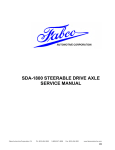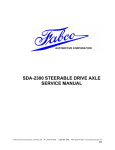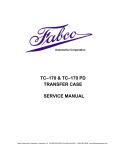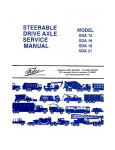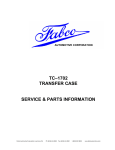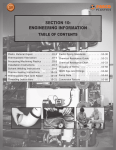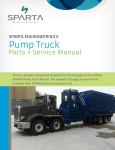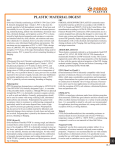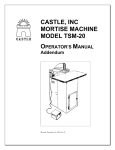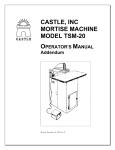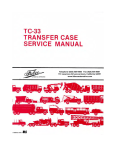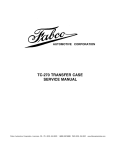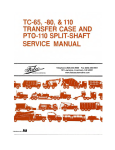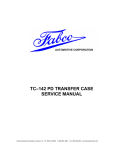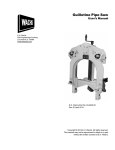Download SDA 23 - Fabco Automotive Corporation
Transcript
151 Lawrence Drive, Livermore, CA 94551 Phone: (925) 454-9500 Fax: (925) 454-9501 www.fabcoautomotive.com TABLE OF CONTENTS VI. CLEANING AND INSPECTION I. DESCRIPTION AND OPERATION A. B. C. D. A. Choice of Cleaning Methods B. Drying and Corrosion Inhibition C. Inspection General Description Operation Operating Instructions Specifications VII. II. LUBRICATION General Precautions for Reassembly Inner Drive Yoke Seal Installation Lower Kingpin Bearing Installation Upper Kingpin Bearing Installation Upper Kingpin Bracket and Kingpin Assembly F .Steering Arm Assembly G.. Inner Axle Shaft and Cardan Joint Assembly H. Spindle and Torque Plate Assembly I . Hub Seal Installation J. Hub, Disc Brake Rotor and Wheel Bearing Assembly K. Lower Kingpin Bracket and Kingpin Assembly L. Outer Yoke Shaft Seal Installation M. Outer Yoke Shaft Assembly N. Installation of Outboard Section of Steerable Drive End O. Disc Brake Caliper Installation P. Final Assembly A. B. C. D. E. A. Wheel Bearings B. Cardan Joints C. Kingpin Bearings D. Differential Carrier E. Steering and Tie Rod Ball Joints Ill. AXLE ADJUSTMENT A. B. C. D. E. F. G. Wheel Bearing Adjustment Kingpin Adjustment Steering Stop Adjustment Camber Adjustment Caster Adjustment Toe-In Adjustment Cardan Joint Adjustment IV. WHEEL BEARING SERVICE A. Hub and Wheel Bearing Disassembly B. Wheel Bearing and Hub Assembly V. STEERABLE DRIVE END DISASSEMBLY A. B. C. D. STEERABLE DRIVE END ASSEMBLY General Precautions for Disassembly Preparation for Disassembly Disc Brake Caliper Removal Removal of Outboard Section of Steerable Drive End E. Outer Yoke Shaft Disassembly F. Outer Yoke Shaft Seal Removal G. Lower Kingpin Bracket and Kingpin Disassembly H. Hub, Disc Brake Rotor and Wheel Bearing Disassembly I . Hub Seal Removal J. Spindle and Torque Plate Disassembly K. Inner Axle Shaft and Cardan Joint Disassembly L. Steering Arm Disassembly M. Upper Kingpin Bracket and Kingpin Disassembly N. Upper Kingpin Bearing Removal O. Lower Kingpin Bearing Removal P. Inner Drive Yoke Seal Removal VIII. DIFFERENTIAL CARRIER REMOVAL AND INSTALLATION A. Removal of Differential Carrier from Axle Housing B. Installation of Differential Carrier into Axle Housing IX. DISC BRAKE SERVICE A. Brake Shoe Replacement B. Caliper Overhaul X. TORQUE SPECIFICATIONS Xl. TOOL REFERENCE PARTS MANUAL Page 27 through 31 ADDITIONAL SERVICE MANUALS Single Reduction Differential Service Manual Double Reduction Differential Service Manual Drive Thru Style Differential Service Manual 625 330B Copyright © 1987 by Fabco, Inc. I. DESCRIPTION & OPERATION Model SDA 23 Steerable Drive Axle A. General Description The SDA 23 front drive axle is nominally rated at a static load capacity of 23,000 pounds. The axle consists of four major assemblies. These assemblies are the axle housing, two steerable drive ends, and the differential carrier. B. Operation Driving forces are put into the axle at the pinion yoke on the differential carrier; they pass through the differential to the inner axle shafts and the inner drive yoke of the cardan joint; they then pass into the outer yoke shaft which connects to the wheel hub and rotates the wheel. When steered, the outer section of each steerable drive end turns about the kingpin centerline. The cardan joint, centered on the kingpin centerline, allows driving forces to turn with the steered wheel ends. The axle is equipped with single free-floating caliper disc brakes, which are hydraulically actuated. C. Operating Instructions In conditions where the vehicle rear wheels might spin, such as sand, loose dirt, mud, snow, ice or ascending grades, the front drive axle can be shifted into operation for improved traction. Engagement can be made at any vehicle speed, unless the rear wheels are spinning. Engagement is best accomplished while the engine is pulling lightly. —2— D. Specifications • Maximum capacity • Brakes— Type Size Certified 23,000 pounds load capacity Disc, single free-floating caliper, hydraulically actuated 15% in. diameter rotor FMVSS 121 • Housing Fabricated, cast steel banjo and tubes • Spring Centers Minimum 32 inches • Spring Width To 4 inches • Caster To customer specifications • Camber Adjustable • Wheels— Mounting Minimum Wheel Size 10 studs on 13 133/ls in. circle 22.5 inches • Differential Carrier Ring Gear Spiral bevel, 18 in. diameter • Single Reduction Ratios 3.70, 3.90, 4.11, 4.33, 4.56, 4.88, 5.43, 6.17, 6.67 • Double Reduction Ratios 5.04, 5.60, 5.90, 6.21, 6.64, 7,39, 8.40, 9.08 • Hi-Entry Ratios 6.05, 6.74, 7.08, 7.45, 7.97, 8.87, 10.08 • Steering arm To Customer specifications • Cardan Joint 10c • Kingpins— Type Inclination • Track Spherical, in Nylatron races, patented Fabco design 8° -i n. over wheel mounting faces Std. 91 91%in. • Axle Shafts— Spline Body -i n.diameter, 24 splines 2%in. 2%in. -i n. diameter • Turn angle 35° • Weight 1990 Ibs. (dry) • Lubrication — Axle Housing Capacity 17 qts. • Options Dual Steering arms —3— Wider Track II. LUBRICATION Recommended Lubricants LUBRICANT ABOVE 32° BELOW 32° Gear Oil MIL-L-2105 B SAE 140 MIL-L-2105 B SAE 90 Chassis Grease MIL-G-10294 MIL-G-10294 Wheel Bearing Grease NLGI Grade #2 NLGI Grade #2 A. Wheel Bearings Wheel bearings require cleaning, inspection, and oil change at every brake shoe and lining replacement. Wheel bearings should be lubricated in accordance with the vehicle manufacturer’s recommendations. The wheel bearings may either be oil lubricated or packed with grease. Grease packed lubrication combined with oil lubrication may also be used. 1. Greased Packed Wheel Bearings a. Refer to Section IV, “Wheel Bearing Service” and follow part A. b. Pack the wheel bearings with wheel bearing grease and refer back to Section IV, and follow part B. 2. Oil Lubricated Bearings a. Cleaning: If bearings are to be cleaned, refer to Section IV, “Wheel Bearing Service” and follow part A. After cleaning, lightly oil bearings and assemble bearings by referring back to Section IV and following part B. b. Draining: Draining oil filled wheel hubs is best accomplished after the vehicle has been operated briefly, allowing the oil to become warm and flow freely. Remove the aluminum hub cap. Fig. 3 Grease Fitting Points of Axle End —5— Drain the hub by removing one bolt from the hub cap (located on the drive flange) and rotating the hub until the open threaded hole is at its lowest position. c. Filling: Rotate the wheel hub until the open threaded hole is on the horizontal centerline of the axle. Fill the hub with lubricant, level with the threaded hole (see fig. 4), and assemble the bolt to the hub cap. Reinstall the aluminum hub cap. The lubricant should be the same as the lubricant used in the differential carrier. See the recommended lubricant chart for choice of proper lubricant. B. Cardan Joint The cardan joints should be lubricated at each chassis lubrication (approximately 1000 mile intervals). Vehicles operating with the cardan joints submerged should have the joints lubricated at more frequent intervals. A low pressure grease gun containing chassis lubricant or gear oil should be connected to the lube fitting on the cardan joint and pressure ap- plied until seepage is detected around each of the rubber cap seals. If all seals do not release lubricant, move the bearing cross laterally in all four directions, then pull down on the bearing cap opposite the side that did not release. Apply lubricant pressure until a flow of lubricant appears. C. Kingpin Bearings The kingpin bearings require lubrication at each chassis lubrication (approximately 1000 mile intervals). To ensure thorough lubrication, the front axle should be raised slightly to relieve weight. A low pressure grease gun containing chassis lubricant should be connected to the lube fittings on the suspension yoke and the upper kingpin bracket and pressure applied. To ensure that old, contaminated grease is completely forced out, pressure should be maintained until new grease appears. D. Differential Carrier Differential carrier lubricant should be changed at the same interval as the rear axle, or after each 10,000 miles of operation. Draining is best accomplished after the vehicle has been operated briefly, allowing the oil to become warm and flow freely. Remove both drain and level plugs and allow housing to empty completely. Clean the magnetic drain plug and install drain plug to housing. Fill housing with gear oil level with level plug hole. Replace level plug and examine housing for leaks around plugs and gasket area. See recommended lubricant chart for choice of proper lubricant, or refer to the Differential Carrier Service Manual supplement for detailed lubrication specifications. E. Steering and Tie Rod Ball Joints Ball joints at tie rod ends and steering arms should be lubricated every 1,000 miles with chassis lubricant. Apply lubricant through lube fittings with a low pressure grease gun until new grease appears around the —6— ball stud shaft. At each lubrication the steering system should be thoroughly inspected for loose, cracked, or worn components. Careful attention to such details is a vital safety factor. Ill. AXLE ADJUSTMENT Note: Brake service is covered in the Disc Brake Service, Section IX. A. Wheel Bearing Adjustment Note: A special wrench is available for adjustment of wheel bearing nuts. See Tool Reference, Section Xl. 1. The front of the vehicle should be raised and properly supported. Remove the front wheels off the axle. 2. Remove the aluminum hub cap. Remove the nut from the end of the yoke shaft. Remove nuts holding outer drive flange to hub. 3. Install two l/2- bolts in drive flange extractor bolt holes and tighten bolts to remove flange from yoke shaft spline (See fig. 9). Note: If the wheel bearings are oil lubricated there will be a loss of oil from inside the hub when the drive flange is removed. Be sure to take the necessary precautions. 2. The lower kingpin jam nut should be loose or loosened and the lower kingpin ball stud backed down all the way. 3. Raise the wheel hub, spindle yoke and kingpin bracket assemblies with a hydraulic jack located under the torque plate. On units with an upper kingpin adjusting screw projecting through the upper kingpin cap or steering arm, adjust the screw to raise the aforementioned parts. Raise unit until the upward movement is resisted by the bottom of the upper kingpin bearing coming into contact with the lower spherical surface of the upper kingpin ball stud. 4. Put a stack of feeler gauges between the lower kingpin bracket and the suspension yoke. The feeler gauges should fill the gap snugly. 4. Remove wheel bearing lock nut and lock-washer from spindle. Loosen wheel bearing adjusting nut. 5. Turn the lower kingpin ball stud upward until the stack of feeler gauges loosen (See fig. 5). 5. Tighten wheel bearing adjusting nut while rotating hub assembly to ensure bearings are properly seated. Back nut off Y2 turn. 6. Back off the lower kingpin ball stud one quarter turn (90°). 6. Tighten wheel bearing adjusting nut to 50 ft. Ibs. torque, then back off l/4 turn. 7. Install wheel bearing lockwasher over adjusting nut dowel with tang in keyway, moving adjusting nut slightly if necessary. Install wheel bearing locknut, tightening nut to 250-400 ft. Ibs. torque. Spin hub and rotor assembly to check for tight or loose wheel bearings. 8. Check end play using a dial indicator. End play should be between .001” and .010”. 7. Tighten the jam nut to the correct torque while restraining the lower kingpin ball stud from turning. On units with an upper kingpin adjusting screw, back off the screw 11’4 turn. Restrain screw while tightening locknut. 8. Remove the jack or hoist. Using a pry bar under the upper kingpin bracket, l/32 to 3/32 play may be observed on a new assembly. After loading, up to l/8 play is acceptable. More than this requires inspection for wear or distortion. 9. Install drive flange and gasket to hub with stud nuts. Tighten nuts to correct torque. 10. Install the self locking nut on the end of the yoke shaft. Tighten to correct torque. 11. Check cardan joint adjustment per Section III, part G. 12. If the wheel bearings are oil lubricated, refill the hub cavity with the appropriate lubricant (See Lubrication Section II). 13. Refer to Section VII, and follow part P, “Final Assembly.” B. Kingpin Adjustment 1. The front of the vehicle should be raised and properly supported. Front wheels should be off the axle. —7— Fig. 5 C. Steering Stop Adjustment 1. Adjust the tie rod to give zero to one eighth inch toe-in (See Section III, part F). 2. Steering stop adjustment is made at the factory and normally needs no further action — unless major parts such as the suspension yoke, spindle yoke or kingpin brackets have been replaced. 3. The purpose of the stop is to protect the cardan joint or any other part from hitting another part in a full turn of the steering. 4. Turn the steering to put the axle first in the full left turn position. The head of the stop bolt should stop the turn before any of the rotating parts in the left hand steerable drive end interferes with another part. Turn the steering to the right and check the corresponding conditions. Note: Power steering stops in the vehicle steering gear should not allow the application of power to the steering when the steerable drive end is in the full turn condition. 5. To adjust the steering stop, loosen the lock nut and adjust the stop bolt. After adjustment, tighten lock nut. D. Camber Adjustment 1. Refer to section V and follow part B. 2. Adjustment is made by the addition or subtraction of shims. Each shim will change the camber W. 3. Remove two bolts from upper kingpin bracket and loosen two stud nuts, separating bracket from torque plate. 4. Remove or install shims as necessary to achieve the desired camber (See fig. 6). 5. Typical setting is l/2’ positive, accomplished by factory installation of a shim between the upper kingpin bracket and torque plate. Consult a tire specialist for specific recommendations. 6. Re-install bolts. Tighten bolts and stud nuts to correct torque. Fig. 6 E. Caster Adjustment 1. Caster is set by vehicle manufacturer and can be adjusted only by shims between the axle spring seat and the spring. Note: Caster change will also change drive line angles. F. Toe-In Adjustment 1. Jack up the front of vehicle. 2. Rotate tires and scribe a line completely around the tires with a crayon held to the center of tire. 3. Lower jack. 4. Loosen tie rod clamp bolts. 5. Measure distance between scribed lines on front and back of tires. 6. Turn tie rod tube with a pipe wrench to adjust toe-in. Set tie rod length until front measurement is 0 to l/8” less than rear measurement. If the vehicle has a full-time front drive system (proportioning differential), alignment should be O-1/8 more in front than in rear, for toe-out. Consult tire specialist for a specific recommendation if specialized tires are used. 7. Tighten tie rod clamp bolts to correct torque. Roll vehicle forward at least a distance equal to four turns of wheels and recheck toe-in. Repeat procedure if necessary to achieve final toe-in dimension. —8— G. Cardan Joint Adjustment Note: Adjustment of the cardan joint is made at factory assembly. Cardan joint adjustment should only be needed if three or more major components have been replaced. Replacement of only one or two components should not alter the shim requirement. Therefore, adjustment is generally not necessary. 1 . Measure the horizontal distance between the inner face of the outer drive yoke and the inner face of the torque plate at the lower kingpin bracket (See fig. 7). Distance should be 3.41” (87 mm). 4. Remove or install shims under the cap as necessary to achieve dimension noted above (See fig. 8). Fig. 8 Fig. 7 2. With one camber adjustment shim in place (See section III, part D), measurement in step one should be as indicated. If additional camber adjustment shims are used, add one-half of added thickness to the normal desired dimension to arrive at proper value for step one. 3. Adjust as follows: After removing the locknut from the end of the yoke shaft and after removing the bolts from the yoke shaft retaining cap. Note: If the wheel bearings are oil lubricated, there will be a loss of oil when the cap is removed. Be sure to take the necessary precautions. 5. Replace the yoke shaft retaining cap with five of the six hub cap bolts and tighten. Check the dimension to ensure proper distance. Repeat procedure if dimension is incorrect. 6. Turn hub so that remaining hole is on the horizontal center line of the axle. 7. Using a suitable low-pressure system, fill the hub cavity with appropriate lubricant level with hole if oil lubrication is being used (See Lubrication, Section II and fig. 4, and page 5.) 8. Install remaining bolt and the yoke shaft retaining locknut. Tighten to the correct torque values. —9— IV. WHEEL BEARING SERVICE A. Hub and Wheel Bearing Disassembly 1. Refer to Section V and follow part B, “Preparation for Disassembly.” 2. Refer to Section V and follow part C, “Disc Brake Caliper Removal” (steps 3 through 6, only). 3. Remove the aluminum hub cap. 4. Remove the yoke shaft retaining locknut from the center of the yoke shaft retaining cap. Early axles were equipped with a capscrew that retained the yoke shaft. (The photographs in this manual are of an early axle.) Remove nuts holding outer drive flange to the wheel hub (see fig. 9). 8. Install transmission jack adapter on a suitable transmission jack (See fig. 11 and Tool Reference, Section XII). Supporting hub and rotor assembly with the transmission jack, back the hub off the spindle, using care to avoid damage to bearing surfaces and threads (See fig. 12). 9. Remove inner wheel bearing cone from spindle. 10. Remove hub and rotor assembly from the jack and remove wheel bearing cups from hub if replacement is necessary. 11. Check hub seal (located in torque plate) for wear or damage and replace if necessary. 5. Install two l/2-1 3 bolts in drive flange extractor bolt holes and tighten bolts to remove flange from yoke shaft spline (see fig. 9). Note: If the wheel bearings are oil lubricated there will be a loss of oil from inside the hub when the drive flange is removed. Be sure to take the necessary precautions. Fig. 10 Fig. 9 6. Remove wheel bearing nuts and lockwasher from spindle with a Fabco wrench (See Tool Reference, Section XII and fig. 10). 7. Rock hub lightly to loosen outer wheel bearing cone. Remove bearing cone and protect from dirt. Fig. 11 —10— FIG. 12 B. WHEEL BEARING AND HUB ASSEMBLY 1. If hub seal is being replaced, apply gasket compound to outer edge of hub seal and install seal into torque plate with a suitable tool. Lubricate inside of seal. 6. Install wheel bearing adjusting nut to spindle with dowel facing outward. 7. Refer to Section III, part A and adjust the wheel bearings. 2. Lubricate inner wheel bearing cone with oil or pack with wheel bearing grease. Install wheel bearing cone on the spindle. 8. Install drive flange and gasket to hub with stud nuts. Tighten nuts to correct torque. 3. Install wheel bearing cups into hub in an arbor press. 9. Check cardan joint adjustment per Section III, part G. 4. Attach hub and rotor assembly to transmission jack adapter (See fig. 11 and Tool Reference, Section Xl). Raise hub to the level of the spindle and place hub over the spindle. Use care to avoid damage to bearing surfaces, threads, and hub seal. Remove transmission jack from hub and rotor assembly. 10. If the wheel bearings are oil lubricated, refill the hub cavity with the appropriate lubricant (See Lubrication Section II). 11. Refer to Section VII, and follow part O, "Disc Brake Caliper Installation" and part P, "Final Assembly." 5. Lubricate outer wheel bearing cone with oil or pack with wheel bearing grease. Place wheel bearing cone over spindle and into the hub. —11— V. STEERABLE DRIVE END DISASSEMBLY A. General Precautions for Disassembly Important: Read this section before starting the disassembly procedure. 1. Follow each procedure closely in each section, making use of both the text and pictures. 2. The outside of the unit should be carefully cleaned before starting the disassembly. If steam cleaning, insure that the breather and air fittings are covered to prevent water from entering assembly. 3. Cleanliness — Provide a clean place to work. It is important that no dirt or foreign material enters the unit during repairs. C. Disc Brake Caliper Removal Brake service and steerable end disassembly requires removal of the brake caliper assembly. 1. Follow part B, this section. 2. Refer to Section IX, “Disc Brake Service” for detailed caliper service procedures. 3. Remove about 213 of the total brake fluid from the brake cylinder reservoir which serves the disc brakes. Do not drain the reservoir completely. Most service will not require removal of the hydraulic line if care is taken to avoid letting the caliper assembly hang by the hydraulic line. 4. Refer to the exploded views located on page 29 as a guide to disassembly. 4. Remove the two bolts from the lower caliper holddown assembly. Remove the two bolts from the upper caliper hold-down assembly while keeping a firm hold on the caliper assembly. 5. Assemblies—When disassembling the various assemblies, lay all parts on a clean bench in the same sequence as removed. This procedure will simplify reassembly and reduce the possibility of losing parts. 5. Lift the caliper off the torque plate and support suitably, do not hang caliper from hydraulic line. Lay the caliper on the suspension. 6. Bearings — Carefully wash and relubricate all bearings as removed and protectively wrap until ready for use. Remove bearings with pullers designed for this purpose, or in manner which will not damage those bearings that will be reused. 7. When necessary to apply a force to remove a part, use of a puller or press would be preferred. However, sometimes it may be necessary to use a soft hammer or bar. B. Preparation for Disassembly 1. Raise the front of the vehicle with a jack and secure with jack stands of suitable capacity. 6. Remove the inner shoe and lining assembly from the torque plate. D. Removal of Outboard Section of Steerable Drive End 1. Follow parts B and C, this section. 2. Remove the cotter pin and castle nut from each tie rod end. Pry between the tie rod end and the tie rod arm and at the same time, strike the side of the tie rod end tapered stud. Remove the tie rod end and repeat the same procedure for the remaining end. Remove the tie rod from the axle. 2. Remove the front wheels. 3. Turn yoke section of the yoke shaft parallel to ground. (Outer shaft yoke must be parallel to ground for disassembly.) 3. If the wheel bearings are oil lubricated, drain the hub cavity by following part A-2b in Section II. Draining is only required if the hub and related parts are to be disassembled. 4. Remove four twelve point capscrews which bolt the cardan joint to the outer yoke shaft and disconnect the cross and bearing assembly from the yoke shaft. 4. If the inner axle shafts are to be removed, drain the axle housing lubricant. 5. Firmly support the outboard side of the steerable drive end with a transmission jack equipped with an adapter (See fig. 13 and Tool Reference, Section Xl). 6. Loosen lower kingpin ball stud jam nut and back down the ball stud all the way. 7. Remove bolts and nuts holding upper kingpin bracket to torque plate. —12— Fig. 13 Fig. 15 8. Withdraw and lower simultaneously, entire assembly from suspension yoke. Use care to avoid damage to the lower kingpin bracket as It drops free of race (See fig. 14). Use a chain hoist and remove outer section from transmission jack. 9. Place end section on floor or workbench for further disassembly. F. Outer Yoke Shaft Seal Removal 1. Refer to thus section and follow part E. 2. Use standard puller to remove the seal. G. Lower Kingpin Bracket and Kingpin Disassembly 1. The lower kingpin ball stud and the lower kingpin bearing are exposed for inspection after part D, page 12. 2. Remove two bolts and nuts retaining the lower kingpin bracket to the torque plate. Remove bracket from torque plate. 3. Back off the lower kingpin ball stud jam nut. The lower kingpin ball stud can be removed by using a 1’2” allen wrench to unscrew ball stud from bracket. H. Hub, Disc Brake Rotor and Wheel Bearing Disassembly Fig. 14 Note: After following part E and G, follow this part while servicing the steerable drive end on the bench. For wheel bearing service only, see Section IV. E. Outer Yoke Shaft Disassembly 1. Place outer section of end on the back side of the torque plate (hub and rotor facing up). 1. Refer to page 12 and follow part D. 2. Remove nuts holding drive flange to hub. 2. Remove the yoke shaft retaining nut and lockwasher from the drive flange hub cap and withdraw shaft. Use care to avoid damage to sleeve bearing inside spindle (See fig. 15). 3. Install two l/2-13 bolts in drive flange extractor bolt holes and tighten bolts to remove flange. (See fig. 9, page 10.) —13— 4. Remove wheel bearing nuts and lockwasher from spindle with a Fabco wrench (See Tool Reference, Section XI and fig. 10, page 10). 5. Rock hub lightly to loosen outer wheel bearing cone. 6. Lift the hub off spindle, using care to avoid damage to bearing surfaces and threads. Remove outer wheel bearing cone from inside the hub and protect from dirt. 7. Remove inner wheel bearing cone from spindle and protect from dirt. 8. Cover spindle with clean shop rag to protect from damage. 9. If necessary, hub and disc brake rotor may be separated by removing nuts from inboard ends of wheel studs. The wheel studs may be pressed from the hub if replacement is necessary. Fig. 16 3. If service of individual components is required, disassemble further by removing four capscrews holding cross and bearing assembly to drive yoke, and bolt and lockwasher holding drive yoke to axle shaft. 10. Remove wheel bearing cups from hub if replacement is necessary. I. Hub Seal Removal L. Steering Arm Disassembly 1. Refer to page 13 and follow part H, steps 1 through 7. 1. Refer to page 12 and follow part B, Paragraph 1 & 2. 2. Disconnect brake line connection that may be attached to the steering arm. 2. Remove hub seal with a suitable puller. J. Spindle and Torque Plate Disassembly 3. Disconnect the steering drag link if so desired —by applying a force between the drag link end and the steering arm and then striking the steering arm radially to the tapered ball connection. Avoid driving on the end of the tapered ball or nut as this will damage the end of the tapered ball before the parts separate. 1. Refer to page 13 and follow part H, steps 1 through 7. 2. Remove nuts attaching spindle to torque plate and remove the spindle. 4. Remove the four locknuts from the steering arm studs and remove the arm. 3. If it is necessary to replace the sleeve bearing inside the spindle, tap the bearing out of the drive yoke end of the spindle. M. Upper Kingpin Bracket and Kingpin Ball Stud Disassembly K. Inner Axle Shaft and Cardan Joint Disassembly 1. Refer to page 12 and follow part D. Follow part L (above), if applicable. 1. Refer to page 12 and follow parts B, C, and D. 2. Withdraw cross and bearing assembly, inner drive yoke and inner axle shaft as an assembly. Use care not to damage the inner axle seal assembly (See fig. 16). 2. Remove bolts and cover plate from upper kingpin bracket. 3. Remove four capscrews which bolt the cardan joint to drive yoke and disconnect journal cross, leaving drive yoke and axle shaft in position to avoid damage to oil seal. —14— 4. Remove locknut from the bottom of the upper kingpin ball stud. Use a small jack to apply pressure to shank of ball stud and release the ball stud from the suspension yoke. If necessary, tap side of upper kingpin bracket with a rawhide mallet, using care not to damage bearing surface (See fig. 17). 5. Remove upper kingpin bracket and upper kingpin ball stud from suspension yoke. 6. Remove O-ring from upper kingpin bracket and discard. N. Upper Kingpin Bearing Removal 1. Remove bearing only if replacing with a new part. 2. Refer to page 14 and follow part M. 3. After taking the necessary precautions, burn the bearing out of the bracket. Use extreme care not to overheat the bracket. Fig. 17 O. Lower Kingpin Bearing Removal 1. After performing part D, page 12 and only if the bearing is to be replaced, drive the bearing out of the suspension yoke by pushing on the lower kingpin disc. P. Inner Drive Yoke Seal Removal 1. The seal should be removed only if being replaced by a new seal assembly. Replacement of only the standard seal portion is not advisable. 2. Refer to page 14 and follow part K. 3. The suspension yoke must be off the axle housing before the seal assembly can be removed. Remove suspension yoke from the axle housing by removing the 12 point capscrews and hardened washers retaining the suspension yoke to the axle housing (See fig. 18). 4. Drive the seal from the suspension yoke with a suitable drift. —15— Fig. 18 VI. CLEANING & INSPECTION A. Choice of Cleaning Methods 1. Steam may be used for external cleaning of completely assembled units. Care must be taken to ensure that water is kept out of the assembly by tightly closing breather caps and other openings. 2. Rough parts such as housings, which are too large to conveniently clean with solvents, may be immersed in a hot solution tank containing a mild alka- line solution. Parts cleaned in hot solution tanks must be rinsed thoroughly to prevent damage by traces of alkaline material. 3. Parts with ground or polished surfaces, such as bearings and shafts, should be cleaned with emulsion cleaners or petroleum solvents. Alkaline hot solution tanks may damage the machined surfaces and such cleaning methods should be avoided. B. Drying and Corrosion Inhibition Soft, clean shop towels should be used to dry parts after cleaning. Compressed air may be used to clean inaccessible areas of large parts such as housing. Bearings should not be spun dry with compressed air, as the lack of lubrication may cause damage to the mating surfaces. Dried parts should be immediately coated with a light oil or corrosion inhibitor to prevent corrosion damage. Parts which are to be stored should also be wrapped in heavy waxed paper. C. Inspection Prior to reassembly, parts which are to be reused must be carefully inspected for signs of wear or damage. Replacement of such parts can prevent costly downtime at a future date. All bearing surfaces, including ball bearing assem- blies and roller bearing cups and cones, should be examined for pitting, wear, or overheating. Shafts may be nicked and marred, or may have damaged threads. Parts which show any sign of damage should be repaired or replaced. —16— VII. STEERABLE DRIVE END ASSEMBLY A. General Precautions for Reassembly Important: Read this section before starting the reassembly procedures. 1. Gaskets — Use new gaskets throughout the axle as it is being rebuilt. Make sure all gaskets are installed, as an omission of a gasket can result in oil leakage. 2. Bolts—to prevent oil leakage, use Permatex forma-gasket #2 pliable setting sealant or equal on all threads. See torque rating chart for recommended torque, Section X. 3. Assembly — Refer to the exploded views located in Parts Manual Section as a guide to reassembly. 4. Initial Lubrication —Coat all splines and seals with Lubriplate during installation to provide initial lubrication, preventing scoring and galling. 2. Press lower kingpin bearing into suspension yoke using a push plate and C-clamp. Use care not to damage bearing. Do not use kingpin ball stud to press in bearing. Lightly lubricate the bearing and install O-ring into bearing. D. Upper Kingpin Bearing Installation 1. Press upper kingpin bearing into upper kingpin bracket in an arbor press, using care not to damage race. 2. Lubricate O-ring and install into upper kingpin bracket. E. Upper Kingpin Bracket and Kingpin Assembly 1. Lubricate socket of upper kingpin bearing and ball section of upper kingpin ball stud. 5. Bearings — Use of flanged-end bearing drivers is recommended for the installation of bearings. These drivers apply equal force to both races of bearing, preventing damage to balls and races and maintaining correct bearing alignment with shaft and bore. If tubular or sleeve type driver is used, apply force to either outer or inner race, or both if needed, depending on which will put the bearing in place without pushing through the balls. 2. Insert ball stud through bearing and bracket and into the tapered hole in suspension yoke. B. Inner Drive Yoke Seal Installation F. Steering Arm Assembly 1. Apply sealer (LOCTITE 601 or equal) to the outer edge of the inner axle seal assembly. Press the seal assembly into the suspension yoke, using suitable drive tool. 2. Apply gasket compound to one side of axle flange gasket and install on suspension yoke. Assemble suspension yoke to axle housing with the hardened washers and 12 point capscrews (See fig 18). Tighten capscrews to correct torque. 3. Assemble plain washer and locknut to ball stud. Tighten nut to correct torque. 4. Install cover plate and gasket to upper kingpin bracket with six bolts, tightening bolts to correct torque; or see part F if applicable. 1. Assemble steering arm to upper kingpin bracket with four locknuts. Tighten locknuts to correct torque. 2. Install drag link to steering arm G. Inner Axle Shaft and Cardan Joint Assembly 1 If the journal cross, inner drive yoke, and axle shaft have been disassembled. assemble inner drive yoke to inner axle shaft. Apply gasket compound to inside of flat washer and assemble the bolt and washer to the inner drive yoke. Inspect axle shaft to ensure yoke is firmly against the retaining ring and that the ring is properly seated in the groove in the shaft. Note: For ease of assembly and if the suspension yoke has been removed from the axle housing. the lower kingpin bearing (part C) can be installed before the suspension yoke is assembled to the axle housing. Follow part C, but install bearing and disc in an arbor press. C. Lower Kingpin Bearing Installation 1. Insert lower kingpin disc into suspension yoke with the lube fitting facing the upper kingpin and pointing fore or aft (not lengthwise with the axle). 2. Insert axle shaft through inner seal until splines engage differential side gear (See fig. 16, page 14). Care must be taken to avoid damaging the seal with sharp spline edges or the hub of the inner drive yoke. When axle shaft and yoke is engaged and firmly held, tighten the bolt connecting the inner drive yoke to the axle shaft to correct torque. —17— 3. Assemble cardan joint cross and bearing assembly to inner drive yoke with four capscrews. Tighten capscrews to correct torque. K. Lower Kingpin Bracket and Kingpin Assembly H. Spindle and Torque Plate Assembly 1. The lower kingpin brackets with integral tie rod arms are right and left handed. The left arm goes on the left steerable drive end and will position the tie rod to the rear when installed on the axle. 1. If the sleeve bearing has been removed, press replacement sleeve bearing into spindle. The small oil groove in the bearing should be on the bottom (that is: on the side opposite the vent fitting, opposite the wheel bearing lockwasher keyway. Press the bearing in until it hits the shoulder in the spindle bore. Do not force up onto the shoulder. 2. Assemble lower kingpin bracket to torque plate. Install two hardened washers and locknuts to the studs. Install remaining two bolts with washers and locknuts to the kingpin bracket. Leave bolts and nuts loose to allow assembly of outboard section of steerable drive end to the suspension yoke. 2. Assemble spindle and gasket to torque plate with ten nuts. Tighten nuts to correct torque. 3. Screw the lower kingpin ball stud into the lower kingpin bracket and install the lower kingpin ball stud jam nut onto the ball stud. Do not tighten the jam nut. I. Hub Seal Installation 4. Lubricate spherical surface of ball stud. 1. Apply gasket compound to outer edge of seal and install seal into torque plate with a suitable tool. Lubricate inside of seal. J. Hub, Disc Brake Rotor and Wheel Bearing Assembly 1. Press inner and outer wheel cups into the hub in an arbor press. 2. Press all replacement wheel studs into the rotor. Note: Left hand threaded wheel studs go into the left side rotor and right hand threaded wheel studs go into the right side rotor. L. Outer Yoke Shaft Seal Installation 1. Apply gasket compound to outer edge of seal and install seal into the spindle with a suitable tool. 2. Lubricate the inside of seal. M. Outer Yoke Shaft Assembly 3. Assemble disc rotor to hub using new stud nuts and tightening to correct torque. 1. Coat the shaft, including the splined sections, with wheel bearing grease and insert outer axle shaft through seal until splines engage with drive flange. Care must be taken to avoid damaging the seal or the sleeve bearing. NOTE: Refer to the Disc Brake Service (Section IX) and inspect the disc rotor for wear and damage. 2. Install yoke shaft locknut on threads and tighten to correct torque. 4. Lubricate inner wheel bearing cone with oil or pack with wheel bearing grease. Install wheel bearing cone on the spindle. N. Installation of Outboard Section of Steerable Drive End 5. Place hub over spindle, using care to avoid damage to bearing surfaces, threads, and hub seal. Proper support of hub and rotor is essential. 1. Using a chain hoist, return outboard section of end to jack and attach assembly to jack adapter (See fig. 13, page 13 and Tool Reference, Section Xl). 6. Lubricate outer wheel bearing cone with oil or pack with wheel bearing grease. Install outer wheel bearing cone over the spindle and into the hub. 2. Raise jack and outboard end assembly until the lower kingpin ball stud enters its bearing, then tilt assembly to align holes in upper kingpin bracket with the studs on the torque plate (See fig. 14, page 13). 7. Install wheel bearing adjusting nut to spindle with dowel facing outward. 8. Refer to Section III, part A and adjust the wheel bearings. 9. Install drive flange and gasket to hub with stud nuts. Tighten nuts to correct torque. — 18— 3. Install camber adjustment shim in place and install two bolts with washers and two stud nuts on upper kingpin bracket, finger tight. 4. Tighten and torque the lower kingpin bracket’s bolts and nuts. 6. Add brake fluid to bring level to ¼” from top of reservoir. 5. Install the steering connecting tie rod. Tighten the castle nuts to correct torque and install new cotter pins. 7. If any hydraulic lines have been disconnected, bleed the hydraulic brake system. Allow the caliper to fill with brake fluid. After all air bubbles have escaped and fluid runs clear from bleeder, close the bleed screw. Replenish the brake fluid in the hydraulic fluid reservoir. 6. Refer to Section III and follow part D to adjust for camber. After making adjustments, tighten the upper kingpin capscrews and stud nuts to correct torque. 7. Refer to Section III and follow part B for kingpin adjustment. 8. “Pump” the brake pedal several times to actuate the piston seals and position the shoe and lining assemblies. 8. Refer to Section III and follow part G for cardan joint adjustment. 9. Check for fluid leakage at all connections under maximum pressure. Refill fluid reservoir as necessary. O. Disc Brake Caliper Installation P. Final Assembly 1. Refer to Section IX, “Disc Brake Service” for detailed caliper service procedures. 1. Install drag link to steering arm. 2. Install inner shoe and lining assembly into torque plate. 3. Install caliper assembly over the hub and rotor and position into grooves in torque plate. 2. Lubricate and add lubricants as described in Section II. 3. Install wheels to axle ends and secure with wheel nuts. 4. Install caliper hold-down assemblies and tighten bolts to correct torque. Note: Right hand threaded wheel nuts go on the right side and left hand threaded wheel nuts go on the left side. Torque wheel nuts to correct torque. 5. Connect the brake line connection that may be attached to the steering arm. 4. Lower vehicle to ground and make all final adjustments covered in Section III. Road test vehicle. — 19 — VIII. DIFFERENTIAL CARRIER Note: For detailed differential carrier service procedures or overhaul, refer to the Differential Carrier Service Manual supplement. Fig. 19 A. Removal of Differential Carrier from Axle Housing B. Installation of Differential Carrier into Axle Housing 1. Remove drain plug and drain lubricant from axle housing. 1. Apply a new gasket to the axle housing with gasket compound. Or use a, suitable, properly applied. form-in-place gasket compound. 2. Disconnect propeller shaft at pinion yoke 3. Refer to Section V and follow part K to remove each inner axle shaft. 2. Install differential carrier in axle housing with a transmission jack equipped with a suitable tool (See fig. 19). 4. Remove bolts and stud nuts holding differential carrier to axle housing. 3. Install differential carrier bolts and stud nuts and tighten to correct torque. 5. Remove differential carrier from axle housing with a transmission jack equipped with a suitable tool (See fig. 19). 4. Connect propeller shaft. Refer to Section VII and follow parts G. N. O. and P to reassemble steerable drive ends. — 20 — IX. DISC BRAKE SERVICE Fig. 20—Kelsey-Hayes Sliding Caliper Dual Piston DISC Brake. A. BRAKE SHOE REPLACEMENT However, do not let the caliper hang on the hydraulic line. Lay the caliper on the suspension. 1-REMOVE CALIPER ASSEMBLY (1) Remove about 93 of the total brake fluid from the brake cylinder reservoir which serves the disc brakes. Do not drain the reservoir completely. (2) With vehicle raised evenly on a jack, or jack stand, remove front wheels. NOTE If more than one brake requires service, work on only one brake at a time, however, shoe and lining assemblies must always be replaced in both brakes. (3) Remove the four (4) screws and remove caliper hold-down assembly. (Fig. 21) Fig. 22—Removing caliper. 2—REMOVING THE SHOE AND LINING ASSEMBLY (1) Remove the inner shoe and lining assembly from the torque plate. (Fig. 23) Fig. 21—Removing screws assembly. and caliper hold-down (4) Lift the caliper off the hub and rotor. (Fig. 22) NOTE It is not necessary to remove the hydraulic line when replacing shoe and lining assemblies. — 21 — Fig. 23—Removing shoe and lining assembly. (2) Remove outer shoe and lining hold-down spring, pin and cup. (Fig. 24) Fig. 24—Removing spring, pin and cup. “C” clamp. push the pistons to the bottom of the piston bores. Fig. 26—Inspecting boot for cracks and cuts. (3) Remove outer shoe and lining assembly. (Fig. 25) Fig. 25—Remove outer shoe and lining assembly. This will provide clearance for the caliper to fit over the hub and rotor when new shoe and linings are installed. (Fig. 27) Fig. 27—Pushing pistons back into caliper. (3) Install outer shoe and lining into caliper and install shoe hold-down spring and pin. (Fig. 28) 3-INSPECTING AND CLEANING CALIPER. (1) Check the inside of the caliper for hydraulic fluid leak. If evidence of fluid leak is noted, the caliper should be overhauled. (2) Wipe the inside of the caliper, clean and check the dust boots for cuts, cracks or other damage. If damage is noted the caliper should be overhauled. (Fig. 26) 4-INSTALLING SHOE AND LINING ASSEMBLIES (1) Install new shoe and lining assembly into torque plate. (Fig. 23) (2) Push the pistons to the bottom of the piston bore. This is done by taking a small block of wood and placing it over the pistons and boots. With a — 22 — Fig. 28—Installing outer shoe and lining assembly. (4) Install caliper assembly over the hub and rotor and position into grooves in torque plate. (5) Install the caliper hold-down assemblies and tighten bolts to 40-ft-lbs. torque. (Fig. 21) (6) Add brake fluid to bring level to ¼” from top of reservoir. (7) If any hydraulic fluid lines have been disconnected, bleed the hydraulic brake system. Pump the brake pedal several times to make sure brake shoes are adjusted. (8) Install the front wheels and lower vehicle CAUTION Use just enough air pressure to ease the pistons out of bore. If the pistons are blown out, even with padding provided, it may be damaged. Warning: Do not place your fingers in front of the piston in an attempt to catch or protect it when applying compressed air. This could result in serious injury (7) Remove and discard the piston boots. (8) Use a pointed piece of wood or plastic to remove the piston seals from the groove in the caliper bore and discard. (Fig. 30) B. CALIPER OVERHAUL Always use denatured alcohol, or brake fluid to clean caliper parts. CAUTION Do not use mineral base cleaning solvents such as gasoline, kerosene, carbon tetrachloride, acetone or paint thinner to clean the caliper. It will cause rubber parts to become soft and swollen in an extremely short time. (1) Remove caliper assembly as explained on Page 21. (2) Disconnect the hydraulic hose and cap or tape the fitting to prevent dirt from entering the hydraulic line. (3) Check the brake hose for worn spots, cracks or other signs of deterioration. Discard the hose if damaged. (4) Drain brake fluid from caliper. Fig. 30—Removing piston seal. CAUTION Do not use a metal tool of any type for this operation as it may damage the caliper bore. 1-CLEANING AND INSPECTION (5) Thoroughly clean the exterior of caliper. (6) Place a small block of wood under caliper pistons. (Approximately 2” thick) Pad the exterior of the caliper with a clean shop towel. Remove the pistons by directing compressed air into the caliper fluid inlet. (Fig. 29) (1) Clean all other parts in clean denatured alcohol. Use dry, filtered compressed air to dry parts and blow out all passages in the caliper and bleeding valve. (2) Carefully examine the piston O.D. for scoring, nicks, corrosion and worn or damaged chrome plating. If any surface defects are detected, replace the piston. The piston O.D. is the primary sealing surface in the caliper assembly. It is manufactured and plated to close tolerances. Refinishing by any means or use of abrasive is not acceptable. (3) Check the bore in the caliper for the same defects as the piston. The piston bore is not plated and stains or minor corrosion can be polished with crocus cloth. Do not use emery cloth or other forms of abrasive. Fig. 29 — Removing pistons from caliper bore. — 23 — (4) Thoroughly clean the caliper after the use of crocus cloth. If the bore cannot be cleaned in this manner, replace the caliper. 2-ASSEMBLING THE CALIPER (6) Press piston straight into caliper piston bore until it bottoms. The boot should slide up the piston as the piston is pushed into the caliper bore and comes to rest in the boot groove in the piston (Fig 33) (1) Place caliper assembly on a clean bench area with the open end of cylinder facing up. (2) Dip new piston seal in clean brake fluid and install in cylinder groove. Gently work the seal around cylinder bore with a finger until it iS properly seated into the seal groove. Be sure the seal is not twisted or rolled in the groove. (Fig. 31) Fig. 33 — Press piston straight into caliper bore. 3-INSTALLING THE CALIPER ASSEMBLY (1) Install new shoe and lining assemblies as described on Page 22 and 23. (2) Install the caliper over the hub and rotor as described on Page 22 and 23. (3) Connect the brake hose to the caliper. Fig. 31 — Installing piston seal in caliper groove. (3) Install dust boot in its cylinder groove similar to installation of the piston seal. (4) Coat the outside diameter of the piston with brake fluid. (5) Use a small flat plastic tool to gradually work dust boot around the piston. (Fig. 32) (4) Bleed the system. Allow the caliper to fill with brake fluid. After all air bubbles have escaped and fluid runs clear from bleeder, close the bleeder screw. Replenish the brake fluid in the hydraulic fluid reservoir. (5) “Pump” the brake pedal several times to actuate the piston seals and position the shoe and lining assemblies. (6) Check for fluid leakage at all connections under maximum pressure. Refill fluid reservoir as necessary. (7) Install front wheels and lower vehicle. 4-HUB AND ROTOR ASSEMBLY (1) Always check the hub and rotor braking surface for deep scores, cracks. and heat checks. (2) Always check hub and rotor lateral runout (“wobble”). Lateral runout must not exceed .008¨ runout. (3) Disc rotors which are scored or warped may not be machined to less than 1.63 inches thickness because of the reductions in strength and heat absorbing mass. Fig. 32—Working boot around closed end of piston. — 24 — X. TORQUE SPECIFICATIONS SIZE LOCATION GRADE TORQUE (FT. LBS.) Differential carrier to axle housing bolts Differential carrier to axle housing stud nuts Axle housing to suspension yoke capscrews Tie rod clamp bolts Tie rod end castle nuts Steering arm nuts Upper kingpin cap bolts Steering stop lock nut Upper kingpin nut Inner axle shaft drive yoke bolt Cardan joint capscrews Upper kingpin bracket bolts Upper kingpin bracket nuts Spindle to torque plate nuts Lower kingpin bracket nuts Lower kingpin jam nut Disc rotor to hub nuts Outer drive flange nuts Hub cap bolts Outer axle shaft nut Input yoke nut Disc brake caliper hold-down bolts Xl. TOOL REFERENCE NAME WHERE USED ILLUSTRATION FABCO PART NUMBER Wheel Bearing Nut Wrench Removal and Installation of Wheel Bearing Nuts Fig. 10, page 10 866 330 Steerable Drive End Disassembly/Assembly Jack Adapter Steerable Drive End Service Fig. 13, page 12 350 204 Note: Prints are available from Fabco to make these tools—contact Fabco engineering and request prints by part number — 25 — — 26 —




























